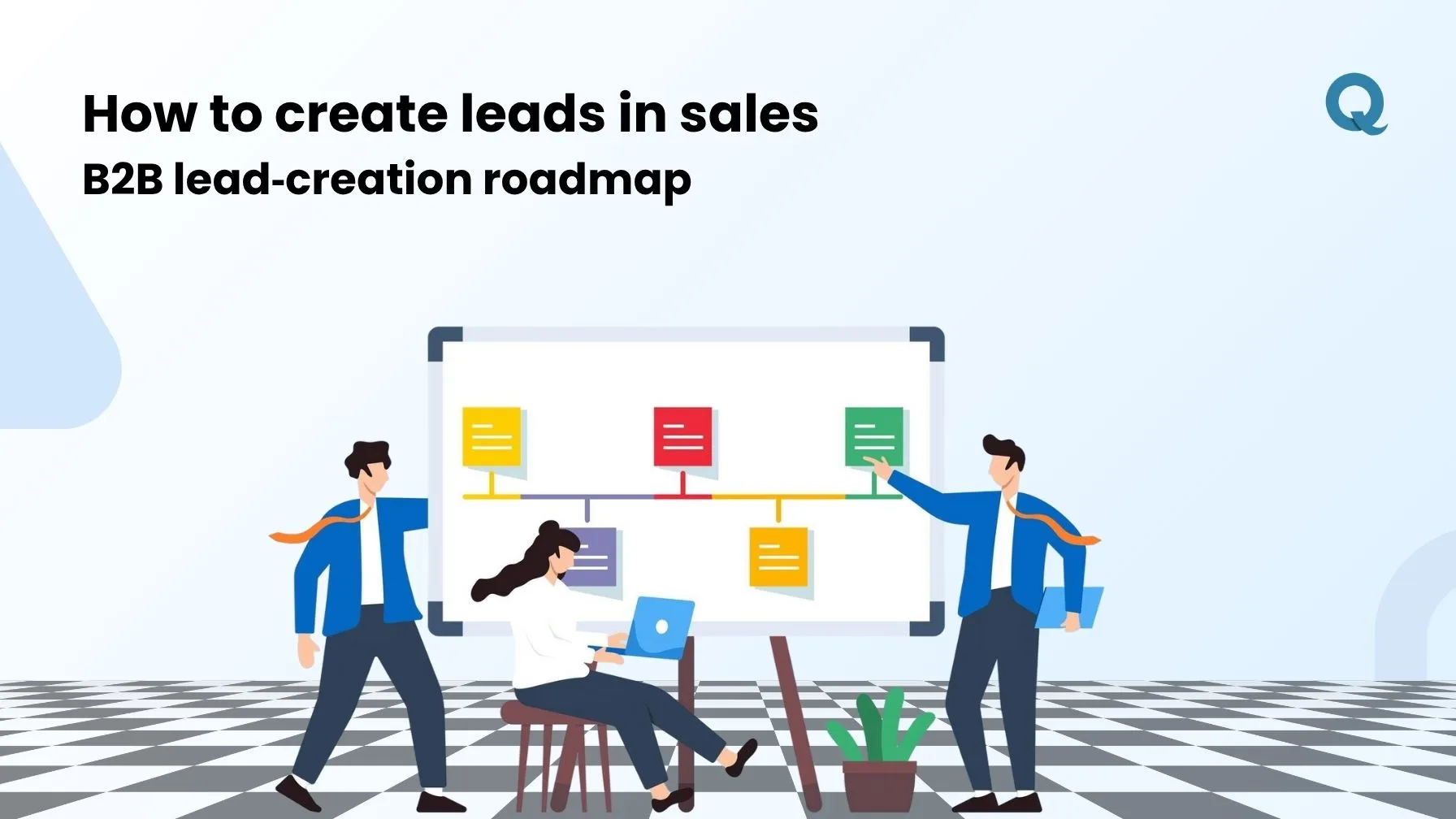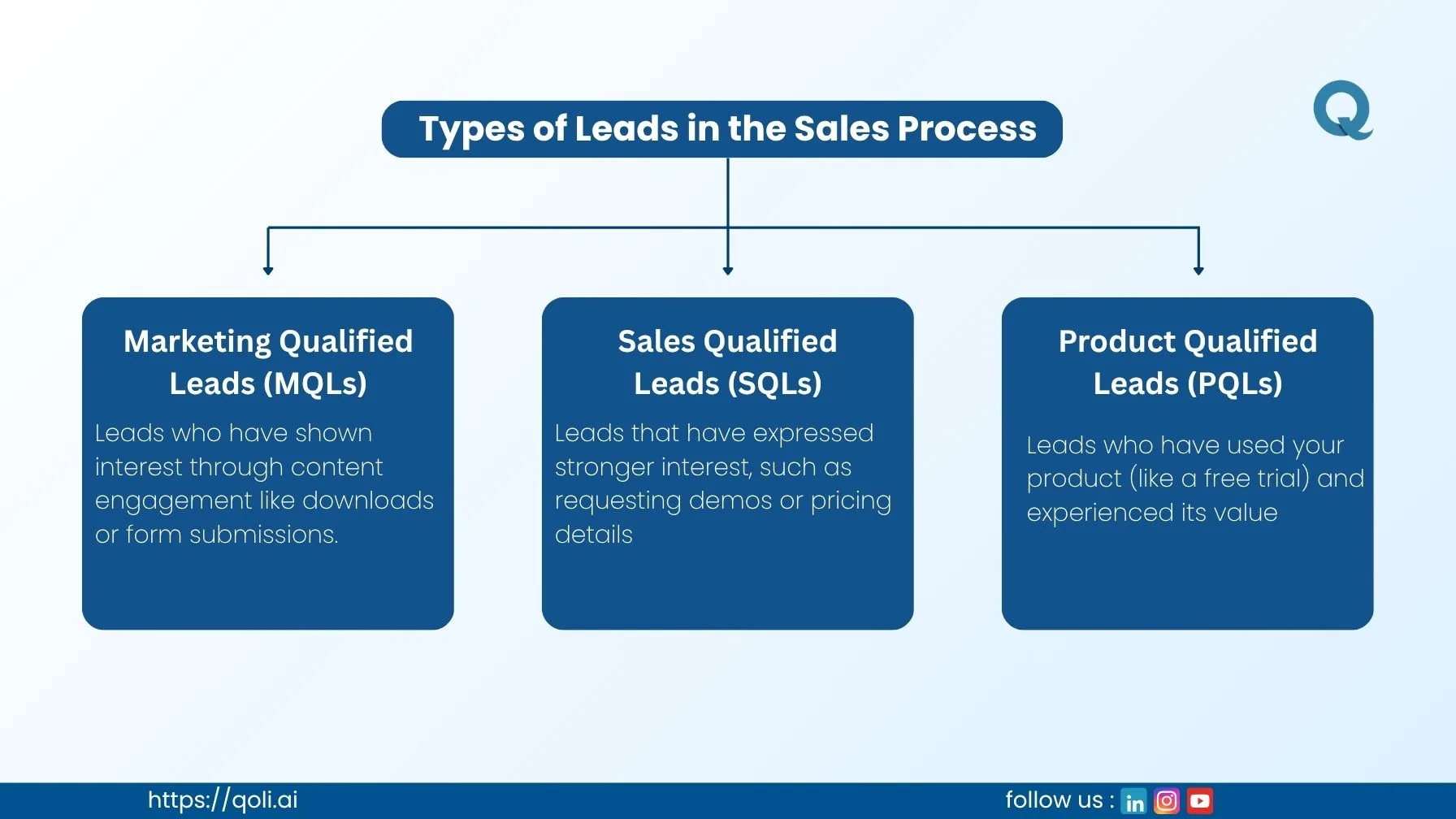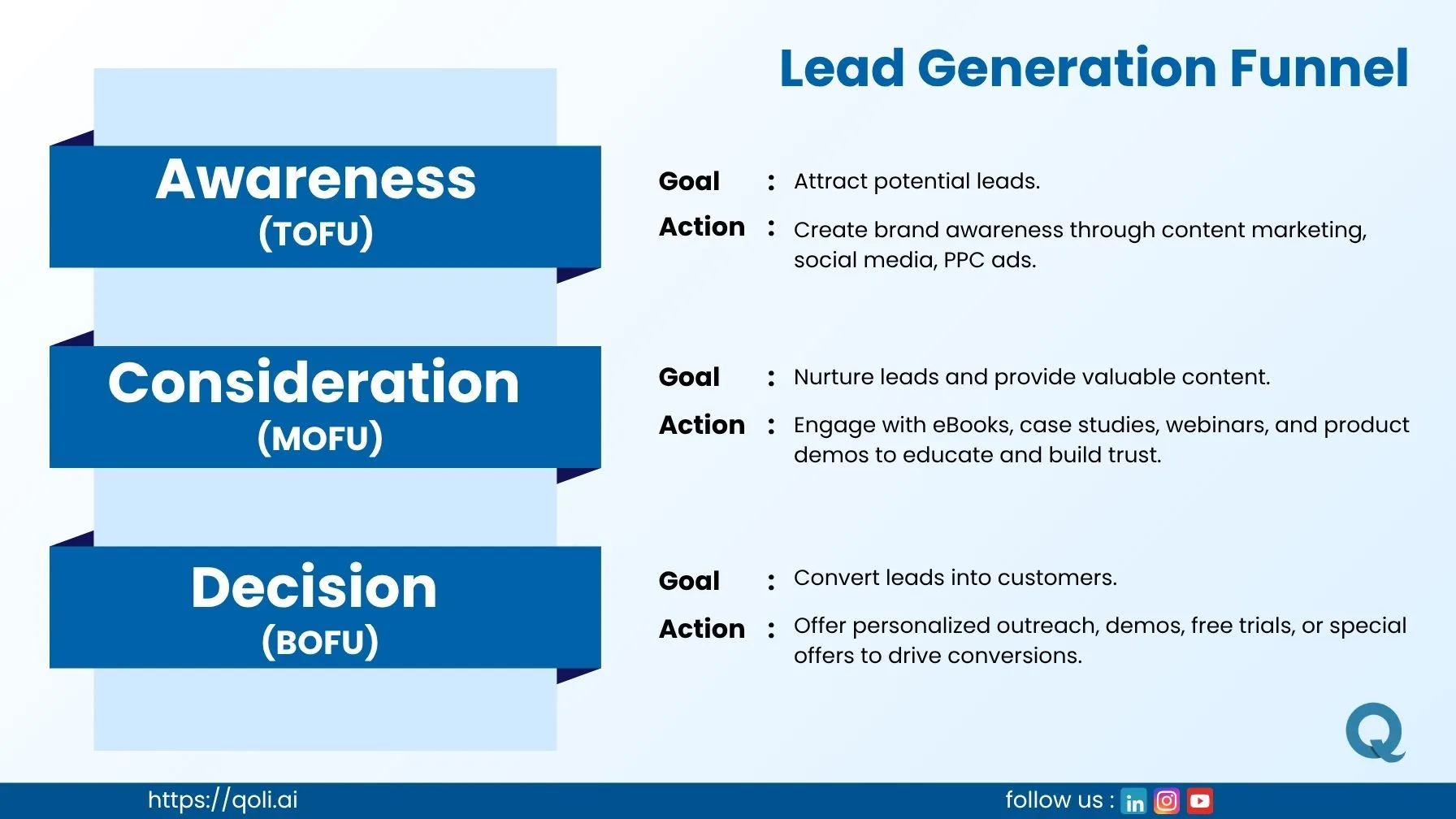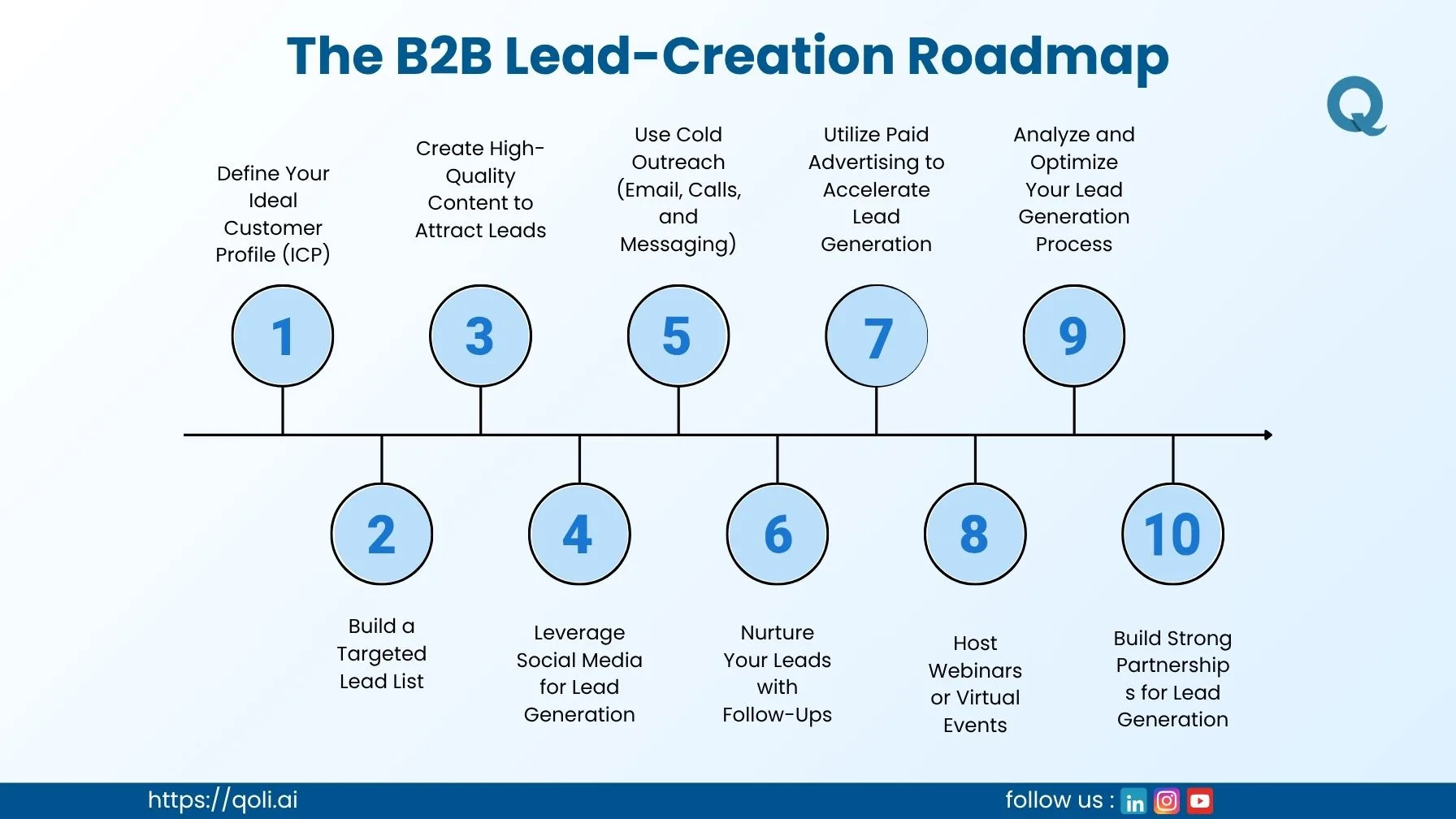How to create leads in sales: B2B lead‑creation roadmap
Learn how to generate high-quality B2B leads with effective strategies, from defining your ideal customer to optimizing your sales funnel for max conversions
Author: Sujith Grandhi
Learn how to generate high-quality B2B leads with effective strategies, from defining your ideal customer to optimizing your sales funnel for max conversions
Author: Sujith Grandhi

How to create leads in sales is a question every business faces when looking to grow and scale. Without a steady stream of quality leads, even the best sales strategies will fall short.
In the B2B sales world, it's not just about attracting any lead, it's about finding the right leads who are genuinely interested in your solutions and ready to engage with your sales team. That’s why 91% of marketers say lead generation is their top priority. When you’re focused on quality over quantity, every lead counts.
This B2B lead-creation roadmap will guide you through the entire lead generation process, helping you define your ideal customer, capture high-quality leads, and convert them into loyal customers. Whether you're just starting or refining your strategy, this roadmap will equip you with the tools and techniques to generate leads in sales that move your business forward.
In sales, a lead refers to a potential customer who has shown interest in your product or service. Leads are the starting point of the sales process, and the goal is to move them through the sales funnel toward becoming a paying customer. The term "lead" can refer to anyone who engages with your business, whether through a form submission, social media interaction, or email inquiry.
To successfully generate leads, you need to capture lead information like contact information (email, phone number, etc.), so you can follow up and nurture them through the lead generation process. Lead generation is the process of attracting and identifying these prospects and then working to convert them into sales-qualified leads.
In the sales process, not every lead you come across is ready to buy, and treating them all the same is where most sales efforts go wrong. Let’s break down the types of leads you’ll meet along the way and how each one needs a different kind of approach.

The lead generation funnel is a process that guides potential customers from their first interaction with your business to becoming a paying customer. This journey is divided into three primary stages:
Each stage helps you generate leads effectively, nurture them, and increase conversions.

At the Awareness stage (TOFU), the goal is to cast a wide net and attract leads who might not yet know about your product or service. This is where you need to create brand awareness and make people aware of the solutions you offer. Content marketing, social media campaigns, PPC advertising services, and other online lead generation methods can help you pull in these cold leads.
The content you create should be engaging and educational to get your audience’s attention. At this stage, they’re just starting their research, and you’re giving them enough value to spark an interest. These leads are generally at the top of the funnel and are just beginning to enter your pipeline.
Once leads have moved past awareness, they enter the Consideration stage (MOFU). These are now marketing-qualified leads (MQLs), people who’ve shown interest and are evaluating different options. They are no longer just browsing, but actively looking for solutions. Now, it’s time to nurture leads by providing more detailed content, such as eBooks, case studies, webinars, and product demos.
Here, you’ll use lead magnets and email marketing to continue engaging with them and move them further down the sales funnel. The goal is to educate these leads about why your product is a good fit and position your brand as a solution to their problems.
At the Decision stage (BOFU), your audience is narrowed down to sales-qualified leads (SQLs). These leads have already evaluated their options and are now ready to make a purchase decision. Sales-qualified leads are highly engaged and need that final push to convert into paying customers. At this point, your focus shifts to personalized outreach, offering demos, free trials, or special offers to drive the conversion.
Effective lead qualification and lead scoring at this stage will ensure you’re targeting the right leads with tailored offers that encourage them to take action.
Now that you know what the lead generation funnel looks like and how each stage works, here’s a simple example that might just make things click. Let’s say you’re offering a location tracking app for businesses, something to help them know where their team is during work hours.
Let’s say, a business owner is feeling frustrated. Their delivery staff is always on the move, but they have no idea who's where or what’s getting done. They’re not out there searching for “location tracking software” yet. They’re just googling things like “how to manage on-field employees better.” That’s when they stumble upon a blog you’ve written, maybe titled “Why You’re Losing Track of Your Field Team (And How to Fix It).” It grabs their attention. They’re not ready to buy anything, but now they’re curious.
A few days later, they’re back. This time they’re reading more, watching a quick explainer video, maybe downloading a simple checklist, “What to Look for in a Tracking App.” They’re starting to connect the dots. They’re not just browsing anymore. They’re thinking, “Okay, this might actually help me.” They’re comparing a few tools now, including yours.
Now they’ve got it narrowed down to two or three options, yours is on the list. They’ve seen the features, they know the price, What they need now is a little confidence. So you offer a free trial or maybe someone from your team reaches out and says, “Want me to walk you through how it works in under 10 minutes?” That personal touch helps. And just like that, they’re in.
So that’s how the funnel works in real life from someone just figuring out they have a problem to finally choosing your solution. Once you understand what your leads need at each stage, it gets a whole lot easier to guide them in the right direction.
Lead generation is at the heart of any successful sales strategy. Without a steady flow of leads, it’s impossible for your sales team to achieve sales goals or close deals effectively. It’s not just about gathering as many leads as possible, but about targeting and engaging the right leads, those who are genuinely interested in your product and ready to convert. Here's why lead generation plays such a crucial role in sales success:
Lead generation keeps your sales pipeline full of qualified leads, giving your sales team more opportunities to engage with prospects and increase the chances of converting them into customers.
By using targeted lead generation methods, you attract high-quality leads. This allows your sales team to focus on prospects who are genuinely interested in your product, improving conversion rates and sales efficiency.
Lead generation attracts qualified leads, leading to more sales-qualified leads (SQLs) and higher conversion rates. With consistent lead flow, your team can close more deals, directly increasing revenue potential.
Effective lead generation builds trust and engages leads over time. By nurturing leads, you increase the likelihood of future conversions, turning leads into long-term customers who can boost sustained sales.
Lead generation provides key data on how leads engage with content, helping refine your sales and marketing strategies to increase conversion rates, leading to more sales success.
Industry: IT Solutions
Challenge: BMC Software needed to convert existing leads into customers and improve lead quality.
Solution: They targeted their existing database to re-engage leads, reducing cost-per-lead and accelerating the sales process.
Results: BMC Software attracted 5,000 leads, increasing marketing-qualified leads by over 2,500 and achieving a 49.5% conversion rate.
The B2B lead-creation roadmap is a structured approach to effectively attract, nurture, and convert high-quality leads. By targeting the right audience and utilizing a series of proven strategies, businesses can optimize their lead generation efforts and build a steady pipeline of sales-qualified leads (SQLs), ultimately driving growth and sales success.

Defining your Ideal Customer Profile (ICP) is the foundation of effective lead generation. By understanding which businesses benefit most from your solution, you can focus on attracting high-quality leads who align with your product or service. This ensures your sales team’s efforts are directed at the right audience and helps increase conversion rates. Clear ICP guidelines reduce wasted efforts on irrelevant prospects and streamline your outreach, allowing you to engage only with the most promising leads for long-term success.
Once your ICP is clear, build a targeted lead list using tools like LinkedIn Sales Navigator or CRM systems. Segment your leads by their level of engagement and fit with your ICP. By targeting the right leads, your outreach becomes more efficient and increases the chances of turning prospects into sales-qualified leads (SQLs).
Content marketing is essential for attracting high-quality leads. 87% of B2B marketers believe that content marketing plays a key role in generating demand and attracting leads. By creating valuable content like eBooks, case studies, and webinars, you offer potential leads a reason to engage with your brand. Use lead magnets to capture contact information in exchange for helpful resources. This approach builds trust with your audience, positions your business as an industry leader, and encourages visitors to take the next step down the funnel. High-quality content helps ensure that you’re attracting the right leads
Strong lead generation practices are the backbone of a growing business, ensuring steady conversions and long-term success.
What’s the best way to qualify a lead in B2B sales?
a) Number of website visits
b) Engagement with content
c) Age of the company
Answer: b) Engagement with content
Social media platforms, particularly LinkedIn, are excellent for lead generation in the B2B space. 80% of B2B leads come from LinkedIn. By sharing valuable content and engaging directly with your target audience, you can convert followers into sales-qualified leads (SQLs). Use social media prospecting to reach decision-makers and start meaningful conversations. Consistent engagement allows you to nurture relationships, making it easier to move leads down the sales funnel. Leveraging social media for lead generation builds credibility and trust, essential for long-term business success.
Myth: "B2B leads only come from cold calling."
Reality: Social media, content marketing, and email marketing are also highly effective tools for generating quality leads in the B2B space.
Cold outreach, via emails, calls, and direct messages remains one of the most effective ways to generate leads in B2B sales. Personalize your outreach to demonstrate how your product can solve the prospect’s pain points. Avoid generic sales pitches and instead offer solutions tailored to their needs. A well-crafted, personalized cold email or cold call can engage sales-qualified leads (SQLs) early in the process, bringing them into the funnel and increasing the likelihood of conversion.
Once you've captured leads, nurturing them is essential. Nurtured B2B leads result in 47% larger purchases compared to non-nurtured leads, while costing 33% less. Implement a consistent follow-up strategy using email marketing, content sharing, and targeted communications. Keep prospects engaged with relevant content that addresses their evolving needs and concerns. The goal is to move leads through the funnel and ensure they don’t lose interest. By offering value at every touchpoint, you build trust and increase the likelihood of converting leads into sales-qualified leads (SQLs), preparing them for final conversion.
Paid ads through platforms like Google Ads and LinkedIn Ads can quickly generate leads. These targeted ads help you reach sales-qualified leads (SQLs) who are actively searching for solutions similar to yours. By focusing on specific keywords and targeting decision-makers, you increase the visibility of your offerings and drive traffic to your landing pages. Paid ads accelerate the lead generation process, providing a direct path for prospects to engage with your content, fill out forms, and convert into high-quality leads.
Hosting webinars and virtual events provides a great opportunity to showcase your expertise and engage directly with prospects. 53% of B2B marketers consider webinars the most effective way to generate high-quality leads. These events are valuable for answering questions, addressing concerns, and showcasing how your solution can solve their business challenges. By inviting targeted leads, you can nurture sales-qualified leads (SQLs) through personal interaction. Offering a call to action at the end of the event, such as a demo or free trial, encourages immediate conversions and keeps the sales process moving forward.
Regularly analyze the performance of your lead generation tactics to identify areas for improvement. By tracking metrics like conversion rates, lead source performance, and engagement levels, you can fine-tune your approach to attract higher-quality leads. Use tools like Google Analytics, CRM systems, and A/B testing to track what works best for your target audience. Continuously optimizing your lead generation efforts ensures you stay ahead of the competition and maximize the potential of every lead.
Suggestion: Regularly analyze your lead generation process to identify opportunities for improvement. Use A/B testing to optimize your approach.
Collaborating with complementary businesses and industry influencers is an excellent way to increase your reach and generate high-quality leads. Co-hosting webinars, writing joint content, or offering joint promotions with your partners allows you to tap into their existing audience. By building these strategic partnerships, you increase your credibility and attract leads who trust your partner’s recommendations, making them more likely to engage with your business.
In today’s competitive World, generating B2B leads requires the right set of tools and technology to optimize your efforts. Leveraging advanced tools can streamline your lead generation process, helping you attract, qualify, and nurture leads more effectively. Here are some essential tools and technologies that can enhance your B2B lead generation efforts:
CRM systems like Salesforce, HubSpot, and Zoho allow businesses to manage and analyze customer interactions and data throughout the lead generation process. By tracking every touchpoint, these systems help you better understand where each lead is in the sales funnel. This enables sales teams to prioritize high-quality leads and personalize communication for better engagement and conversion.
Tools like LinkedIn Sales Navigator and Hunter.io can help sales teams find targeted leads by searching for prospects within specific industries or job titles. These tools provide valuable contact information, including email addresses, making it easier to connect with the right leads. Using these tools, you can build a targeted lead list and reach out to the most relevant sales-qualified leads (SQLs).
Email marketing tools like Mailchimp, ActiveCampaign, and SendinBlue are crucial for lead nurturing. These platforms allow you to create automated email sequences that guide your leads through the sales funnel. Whether you’re sending welcome emails or follow-up sequences, these tools help maintain communication with B2B leads. By segmenting your email lists, you can send tailored messages to marketing-qualified leads (MQLs) and sales-qualified leads (SQLs), increasing the chances of conversion.
Social media platforms like LinkedIn, Twitter, and Facebook are essential for engaging B2B leads. Tools like Hootsuite, Buffer, and Sprout Social help you schedule posts, track engagement, and analyze performance across multiple platforms. You can use these tools to engage with targeted leads, share valuable content, and build relationships with potential clients. Social media prospecting helps you move leads down the funnel by starting meaningful conversations with decision-makers.
Using lead scoring tools like LeadSquared or HubSpot helps you prioritize leads based on their level of engagement. By scoring leads based on their actions (such as email opens, form submissions, or website visits), you can identify which sales-qualified leads (SQLs) are more likely to convert. This system allows you to focus your sales efforts on the right leads, increasing efficiency and conversion rates.
Artificial Intelligence (AI) technologies are becoming integral to lead generation. Platforms like Qoli integrate AI to automate and enhance the lead management process. Qoli provides location tracking, call monitoring, and message tracking capabilities, offering a clear view of customer behavior and engagement. This data helps businesses to qualify leads and identify prospects who are likely to convert. Additionally, Qoli’s features assist in monitoring sales calls and customer interactions, making it easier to assess whether a lead is ready for direct sales engagement.
Qoli improves B2B lead generation by providing call recording and call logs. These features help sales teams qualify leads more effectively by reviewing conversations, tracking lead engagement, and optimizing follow-ups. Call insights enhance personalization, increase conversion rates, and ensure sales calls meet company standards for better results.
B2B lead generation can be a challenging process, especially when you face obstacles that slow down progress. Understanding these challenges and knowing how to address them is key to building a successful lead generation strategy. Here are some common challenges and how to overcome them:

One of the biggest challenges in B2B lead generation is identifying the right leads. With so many businesses and decision-makers out there, it can be difficult to narrow down the target audience.
Solution: Define your Ideal Customer Profile (ICP) to better understand the leads that are most likely to benefit from your product or service. Use CRM tools, lead scoring, and social media tools to better segment and track the right leads.
It's easy to generate a large volume of leads, but the real challenge is ensuring they are high-quality leads that are likely to convert.
Solution: Use content marketing, lead magnets, and ABM (Account-Based Marketing) to attract qualified leads. By offering valuable content that speaks directly to your audience’s pain points, you can ensure you're attracting marketing-qualified leads (MQLs) who are more likely to move through the funnel.
Many B2B leads fall out of the sales pipeline because they weren't nurtured properly. Without the right follow-ups and consistent communication, leads lose interest.
Solution: Implement a strong lead nurturing process with email campaigns, webinars, and personalized follow-ups. Use automation tools to send timely reminders, product updates, and relevant content to keep leads engaged.
B2B sales cycles can be long, making it difficult to maintain lead interest over extended periods. Decision-making often involves multiple stakeholders, causing delays.
Solution: Break the sales process into smaller, manageable steps. Use CRM tools to track engagement and follow-up regularly. Leverage personalized content that addresses different stakeholders' needs, moving the process along smoothly.
The B2B market is highly competitive, and it can be hard to stand out among similar offers.
Solution: Focus on value propositions and differentiate yourself from competitors by providing personalized, data-driven insights. Use social proof, such as case studies or testimonials, to build trust and credibility with your leads.
Knowing how to create leads in sales is essential for driving business growth. By following this B2B lead-creation roadmap, you ensure that your sales efforts are directed toward the right leads, those genuinely interested in your solutions and ready to engage. Defining your Ideal Customer Profile (ICP), creating valuable content, leveraging social media, and nurturing leads through each stage of the sales funnel will help you move leads toward conversion.
Using powerful tools to track call recordings, monitor call logs, and analyze customer behavior can significantly improve lead qualification and follow-up efficiency. With the right combination of strategy and technology, you can build a steady pipeline of sales-qualified leads (SQLs) and drive consistent sales growth. By focusing on how to create leads in sales, you’ll ensure long-term success and boost your business’s revenue potential.